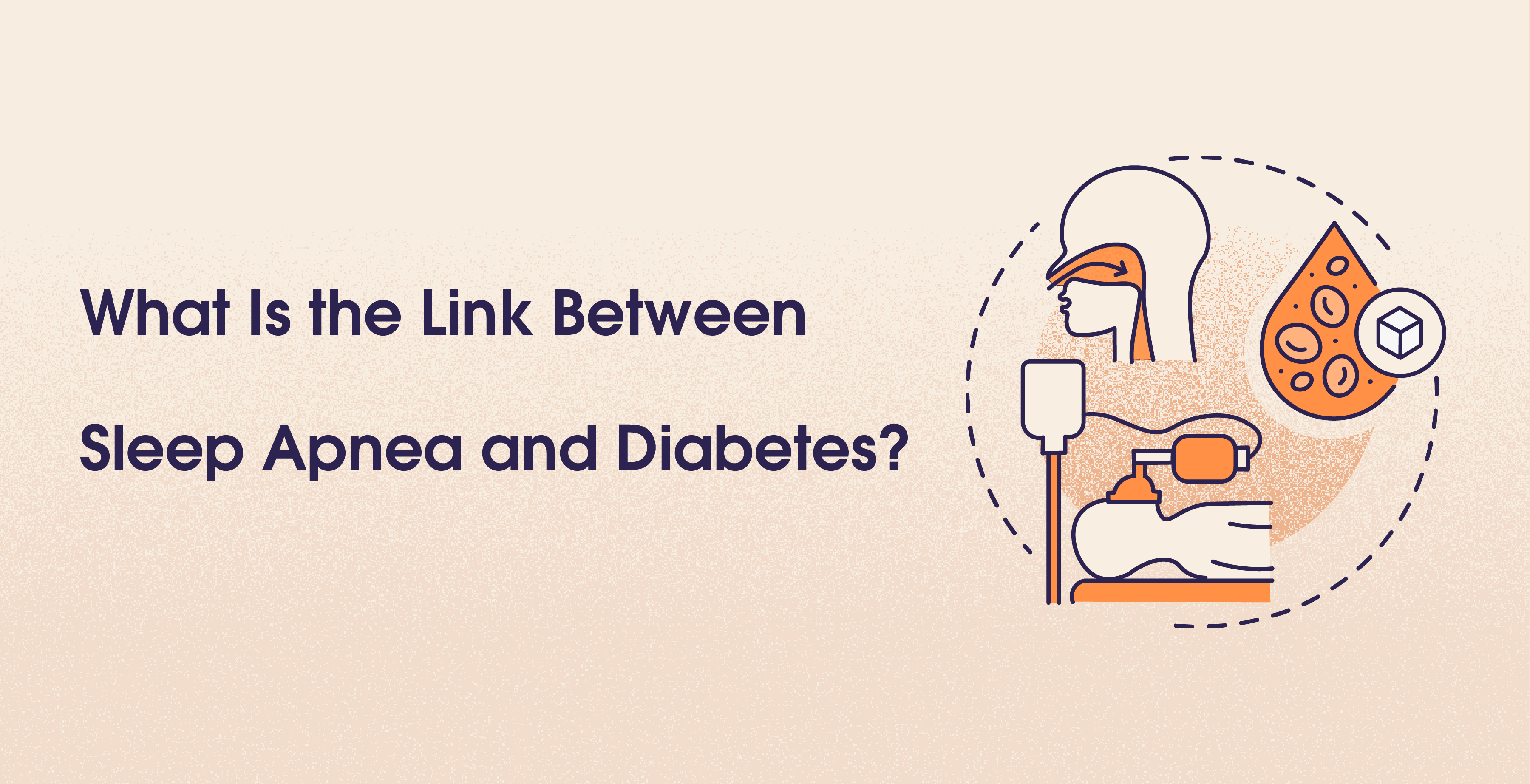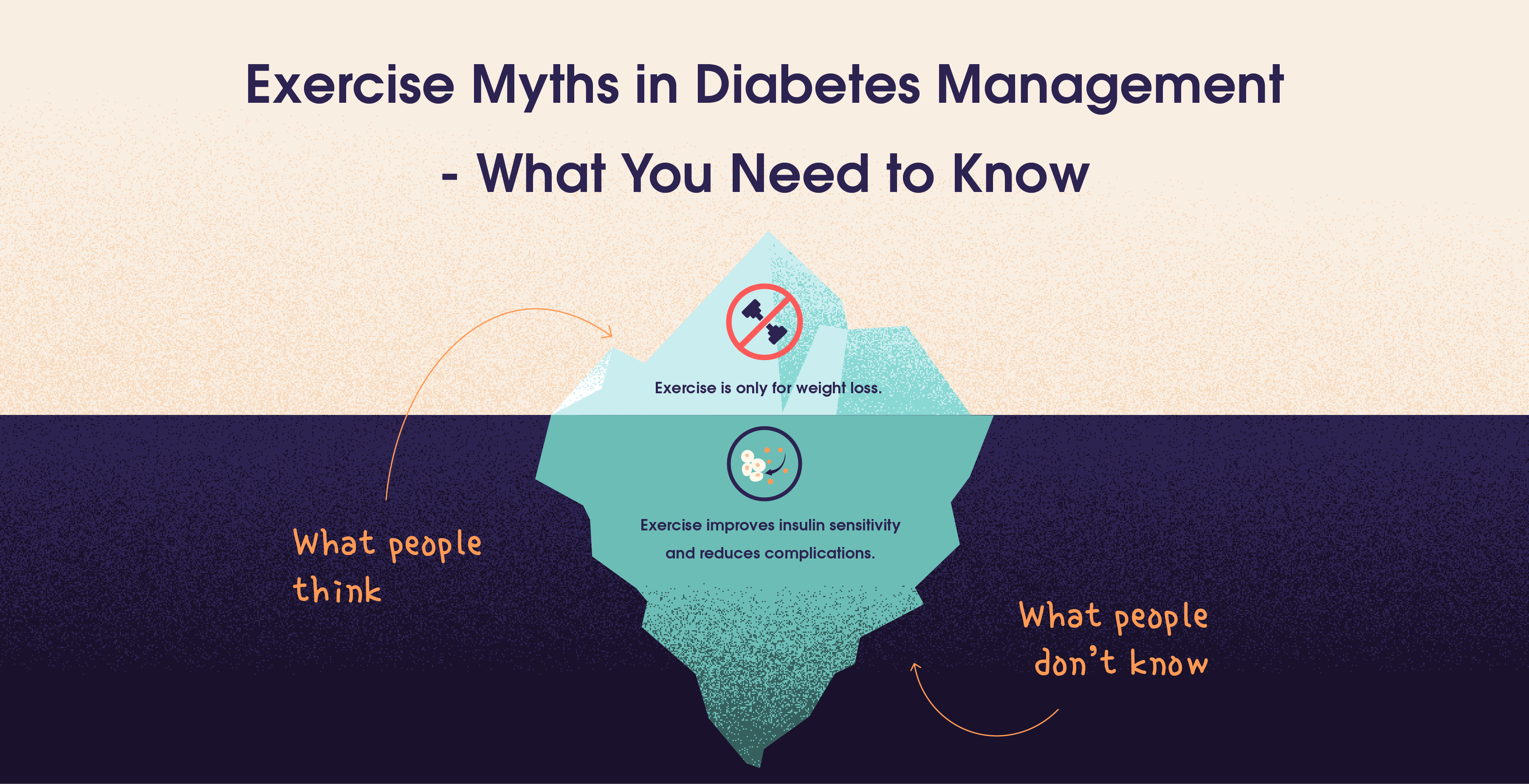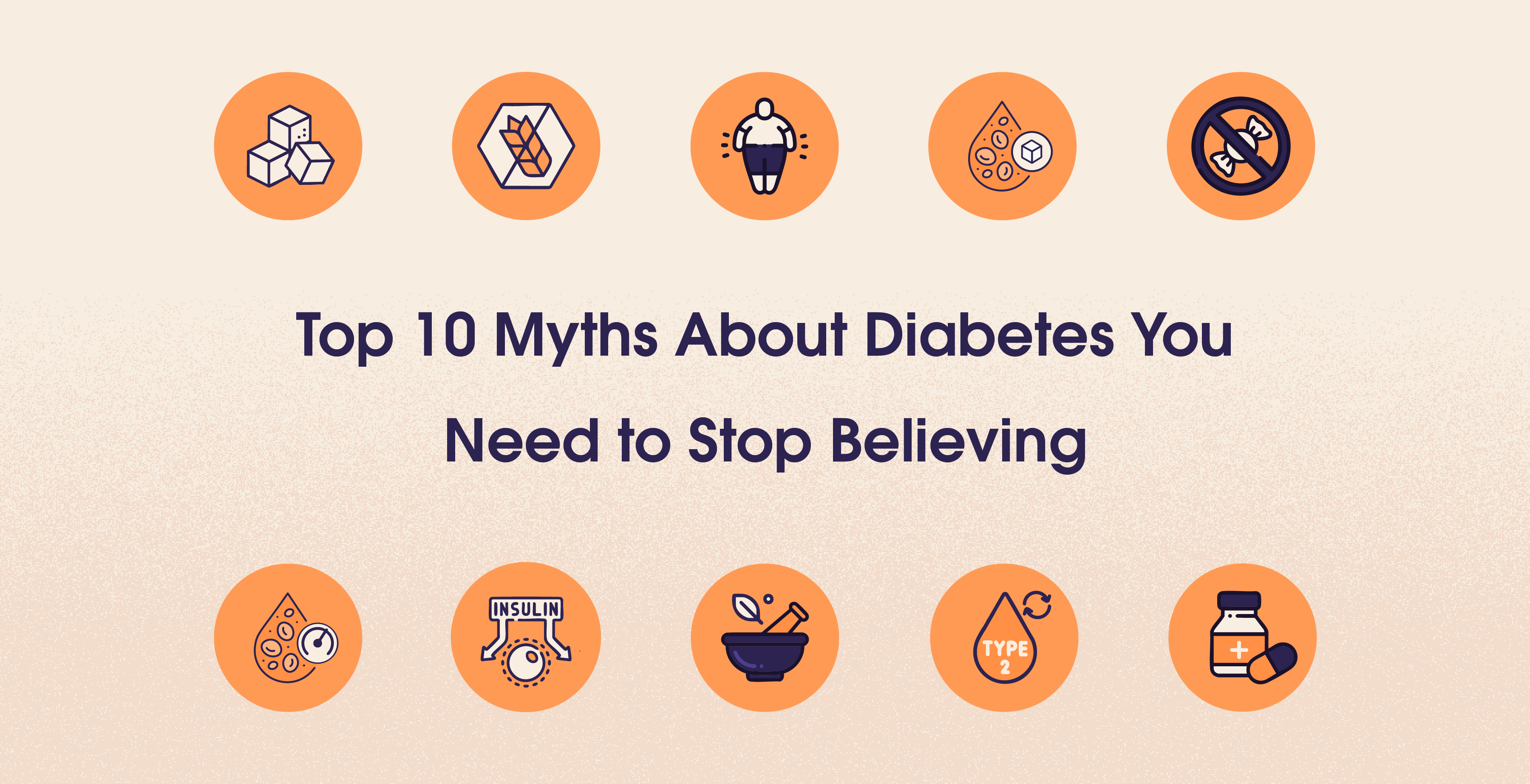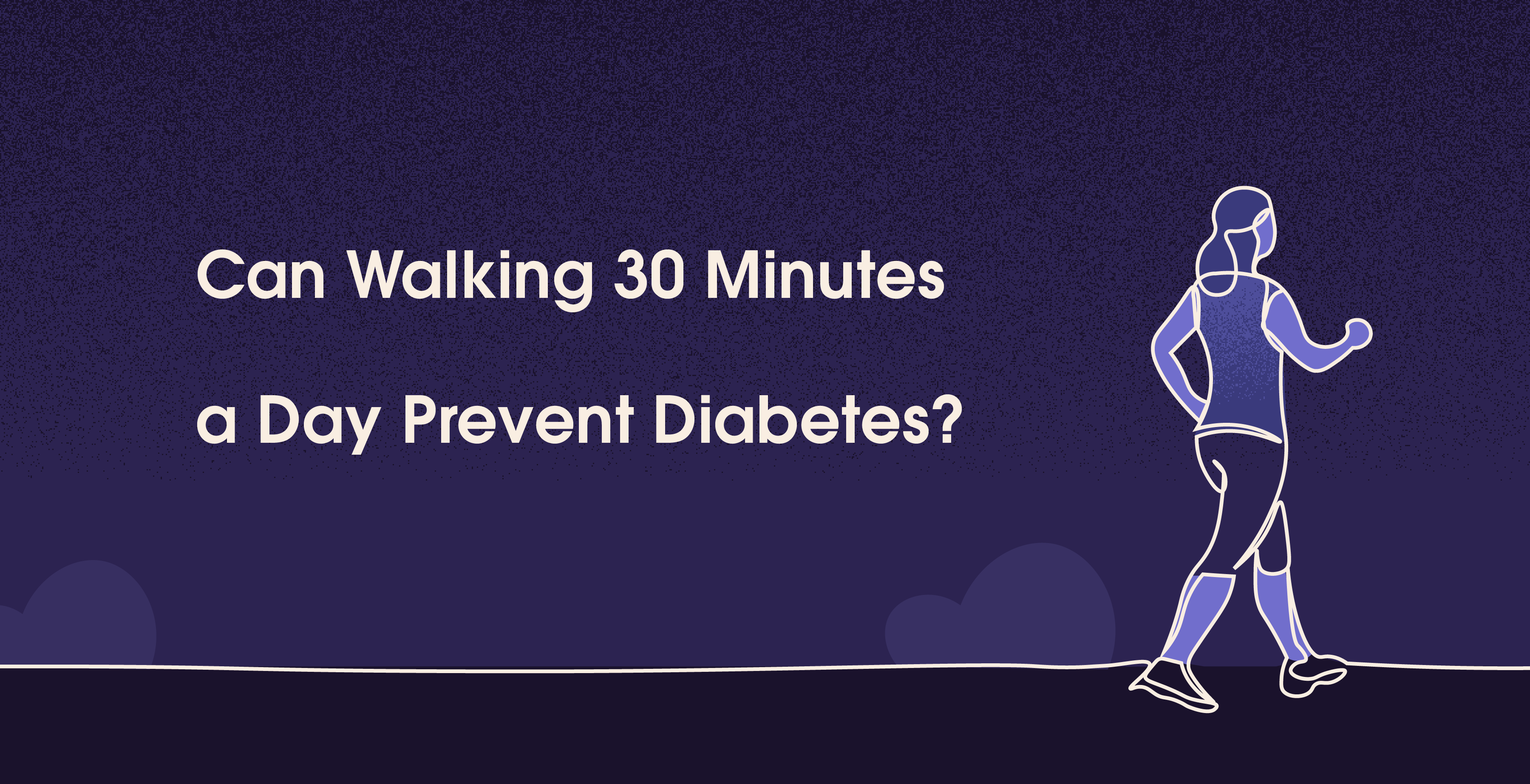What Is the Link Between Sleep Apnea and Diabetes?
Feb 4, 2025
Sayfali Rawlani



Table Of Contents
You might be thinking, "How on earth could something like sleep apnea have anything to do with diabetes?" At first glance, they seem like totally separate health issues, right? One is about struggling to breathe while sleeping, and the other is all about blood sugar levels. But dig a little deeper, and you'll find they’re oddly intertwined in ways that might surprise you.
Highlights
Sleep apnea and diabetes are interconnected, with one condition often worsening the other.
Sleep apnea triggers cortisol release, which leads to insulin resistance and blood sugar spikes.
Diabetes, especially with excess weight, increases the risk of sleep apnea by putting pressure on airways.
Poor-quality sleep from apnea disrupts appetite hormones, causing cravings and weight gain.
Chronic inflammation is a shared culprit in both conditions, fueling insulin resistance and worsening symptoms.
Sleep apnea-induced low oxygen levels lead to adrenaline surges, causing blood sugar spikes.
Treating sleep apnea with CPAP therapy improves blood sugar control and overall health.
Lifestyle changes like weight loss, a balanced diet, and regular exercise help manage both conditions.
Ignoring sleep apnea increases the risks of heart disease, stroke, and long-term complications.
Early detection and treatment of either condition can significantly improve quality of life.
Two Sides of the Same Coin
Picture this: sleep apnea, with its constant interruptions to your breathing, creates a whole cascade of stress in your body. And no, I’m not just talking about tossing and turning or waking up groggy. This stress messes with hormones like cortisol—the so-called “stress hormone.” When cortisol is constantly high, your blood sugar levels can go haywire, paving the way for insulin resistance. And voilà, you’re suddenly on the fast track to type 2 diabetes.
The other side of the story? Diabetes can worsen sleep apnea too. People with diabetes are more likely to carry excess weight, and this weight can press against the airways during sleep, causing those dreaded pauses in breathing. It’s like a vicious cycle—one condition feeds the other.
How Sleep Apnea Wreaks Havoc
Here’s the deal with sleep apnea. When you stop breathing in your sleep, even for just a few seconds, your oxygen levels drop. Your body panics and wakes you up just enough to start breathing again. This can happen dozens (or even hundreds!) of times a night. And while you might not fully remember these wake-ups, your body does.
The constant interruptions lead to poor-quality sleep, and let’s be real—bad sleep is a recipe for disaster. Sleep deprivation throws your entire system off balance. Your appetite hormones? Out of whack. Your ability to regulate blood sugar? Compromised. It’s no wonder people with untreated sleep apnea often find themselves facing elevated blood sugar levels.
Inflammation: The Hidden Culprit
Have you ever felt like your body is just... angry? Chronic inflammation is a sneaky villain in this story. Both sleep apnea and diabetes are known to fuel inflammation. When your body is constantly in “alert mode” from low oxygen during sleep or blood sugar spikes, it starts treating everything like a threat. This low-level inflammation damages your cells over time, worsening insulin resistance and making sleep apnea symptoms harder to manage.
It’s like adding fuel to an already raging fire.
The Weight Factor
Let’s talk about the elephant in the room—weight. Obesity is one of the biggest risk factors for both sleep apnea and diabetes. Carrying extra pounds, especially around the neck or belly, can put pressure on the airways, making it harder to breathe during sleep. At the same time, it also increases insulin resistance. So, it’s a double whammy.
Here’s where it gets tricky: sleep apnea makes it harder to lose weight. Poor sleep messes with hormones like ghrelin and leptin, which control hunger and fullness. Ever noticed how you crave junk food after a bad night’s sleep? Exactly. Now imagine that on repeat, every single night.
What About Blood Sugar Spikes?
When your body doesn’t get enough oxygen at night, it freaks out. It thinks you’re in some kind of danger and releases adrenaline to “save” you. This stress response sends blood sugar levels soaring. Over time, these nightly blood sugar spikes can push you toward prediabetes or full-blown diabetes.
It’s not just about the spikes, though. Your cells also become less sensitive to insulin, the hormone that helps manage blood sugar. So even when you’re eating a balanced diet, your body struggles to process it properly.
Breaking the Cycle
Here’s the silver lining—this cycle can be broken. Treating sleep apnea often leads to better blood sugar control, and vice versa. Continuous Positive Airway Pressure (CPAP) therapy, the go-to treatment for sleep apnea, helps keep your airways open while you sleep. With better oxygen levels and uninterrupted rest, your body finally has a chance to reset.
But it’s not just about CPAP machines. Losing weight, even just a little, can make a world of difference. Regular exercise, eating a balanced diet, and managing stress all play a part in keeping both sleep apnea and diabetes in check.
Why You Shouldn’t Ignore the Signs
Ignoring sleep apnea isn’t just about feeling tired the next day. It’s about the long-term health risks. Left untreated, sleep apnea doesn’t just increase your risk of diabetes—it also ups the chances of heart disease, stroke, and other serious conditions.
Pay attention to the signs: loud snoring, waking up gasping for air, daytime fatigue, or even unexplained mood swings. And if you’re already living with diabetes, keep an eye out for these symptoms. The sooner you catch and treat sleep apnea, the better your chances of preventing its nasty side effects.
Wrapping It Up
So, what’s the takeaway here? Sleep apnea and diabetes might seem like two separate issues, but they’re connected in more ways than you’d think. Treating one often improves the other, and tackling both together can lead to major health improvements.
If you’ve been dealing with symptoms of either—or both—don’t just brush them off. Talk to a healthcare provider. Your body will thank you for it. After all, good health starts with a good night’s sleep.
References
You might be thinking, "How on earth could something like sleep apnea have anything to do with diabetes?" At first glance, they seem like totally separate health issues, right? One is about struggling to breathe while sleeping, and the other is all about blood sugar levels. But dig a little deeper, and you'll find they’re oddly intertwined in ways that might surprise you.
Highlights
Sleep apnea and diabetes are interconnected, with one condition often worsening the other.
Sleep apnea triggers cortisol release, which leads to insulin resistance and blood sugar spikes.
Diabetes, especially with excess weight, increases the risk of sleep apnea by putting pressure on airways.
Poor-quality sleep from apnea disrupts appetite hormones, causing cravings and weight gain.
Chronic inflammation is a shared culprit in both conditions, fueling insulin resistance and worsening symptoms.
Sleep apnea-induced low oxygen levels lead to adrenaline surges, causing blood sugar spikes.
Treating sleep apnea with CPAP therapy improves blood sugar control and overall health.
Lifestyle changes like weight loss, a balanced diet, and regular exercise help manage both conditions.
Ignoring sleep apnea increases the risks of heart disease, stroke, and long-term complications.
Early detection and treatment of either condition can significantly improve quality of life.
Two Sides of the Same Coin
Picture this: sleep apnea, with its constant interruptions to your breathing, creates a whole cascade of stress in your body. And no, I’m not just talking about tossing and turning or waking up groggy. This stress messes with hormones like cortisol—the so-called “stress hormone.” When cortisol is constantly high, your blood sugar levels can go haywire, paving the way for insulin resistance. And voilà, you’re suddenly on the fast track to type 2 diabetes.
The other side of the story? Diabetes can worsen sleep apnea too. People with diabetes are more likely to carry excess weight, and this weight can press against the airways during sleep, causing those dreaded pauses in breathing. It’s like a vicious cycle—one condition feeds the other.
How Sleep Apnea Wreaks Havoc
Here’s the deal with sleep apnea. When you stop breathing in your sleep, even for just a few seconds, your oxygen levels drop. Your body panics and wakes you up just enough to start breathing again. This can happen dozens (or even hundreds!) of times a night. And while you might not fully remember these wake-ups, your body does.
The constant interruptions lead to poor-quality sleep, and let’s be real—bad sleep is a recipe for disaster. Sleep deprivation throws your entire system off balance. Your appetite hormones? Out of whack. Your ability to regulate blood sugar? Compromised. It’s no wonder people with untreated sleep apnea often find themselves facing elevated blood sugar levels.
Inflammation: The Hidden Culprit
Have you ever felt like your body is just... angry? Chronic inflammation is a sneaky villain in this story. Both sleep apnea and diabetes are known to fuel inflammation. When your body is constantly in “alert mode” from low oxygen during sleep or blood sugar spikes, it starts treating everything like a threat. This low-level inflammation damages your cells over time, worsening insulin resistance and making sleep apnea symptoms harder to manage.
It’s like adding fuel to an already raging fire.
The Weight Factor
Let’s talk about the elephant in the room—weight. Obesity is one of the biggest risk factors for both sleep apnea and diabetes. Carrying extra pounds, especially around the neck or belly, can put pressure on the airways, making it harder to breathe during sleep. At the same time, it also increases insulin resistance. So, it’s a double whammy.
Here’s where it gets tricky: sleep apnea makes it harder to lose weight. Poor sleep messes with hormones like ghrelin and leptin, which control hunger and fullness. Ever noticed how you crave junk food after a bad night’s sleep? Exactly. Now imagine that on repeat, every single night.
What About Blood Sugar Spikes?
When your body doesn’t get enough oxygen at night, it freaks out. It thinks you’re in some kind of danger and releases adrenaline to “save” you. This stress response sends blood sugar levels soaring. Over time, these nightly blood sugar spikes can push you toward prediabetes or full-blown diabetes.
It’s not just about the spikes, though. Your cells also become less sensitive to insulin, the hormone that helps manage blood sugar. So even when you’re eating a balanced diet, your body struggles to process it properly.
Breaking the Cycle
Here’s the silver lining—this cycle can be broken. Treating sleep apnea often leads to better blood sugar control, and vice versa. Continuous Positive Airway Pressure (CPAP) therapy, the go-to treatment for sleep apnea, helps keep your airways open while you sleep. With better oxygen levels and uninterrupted rest, your body finally has a chance to reset.
But it’s not just about CPAP machines. Losing weight, even just a little, can make a world of difference. Regular exercise, eating a balanced diet, and managing stress all play a part in keeping both sleep apnea and diabetes in check.
Why You Shouldn’t Ignore the Signs
Ignoring sleep apnea isn’t just about feeling tired the next day. It’s about the long-term health risks. Left untreated, sleep apnea doesn’t just increase your risk of diabetes—it also ups the chances of heart disease, stroke, and other serious conditions.
Pay attention to the signs: loud snoring, waking up gasping for air, daytime fatigue, or even unexplained mood swings. And if you’re already living with diabetes, keep an eye out for these symptoms. The sooner you catch and treat sleep apnea, the better your chances of preventing its nasty side effects.
Wrapping It Up
So, what’s the takeaway here? Sleep apnea and diabetes might seem like two separate issues, but they’re connected in more ways than you’d think. Treating one often improves the other, and tackling both together can lead to major health improvements.
If you’ve been dealing with symptoms of either—or both—don’t just brush them off. Talk to a healthcare provider. Your body will thank you for it. After all, good health starts with a good night’s sleep.
References
Table Of Contents
Table Of Contents
Table Of Contents
Read More


Apr 2, 2025
Sayfali Rawlani


Feb 17, 2025
Aparna Hurtis


Feb 10, 2025
Aparna Hurtis



Company
Copyright © 2025 trst health. All right reserved.

